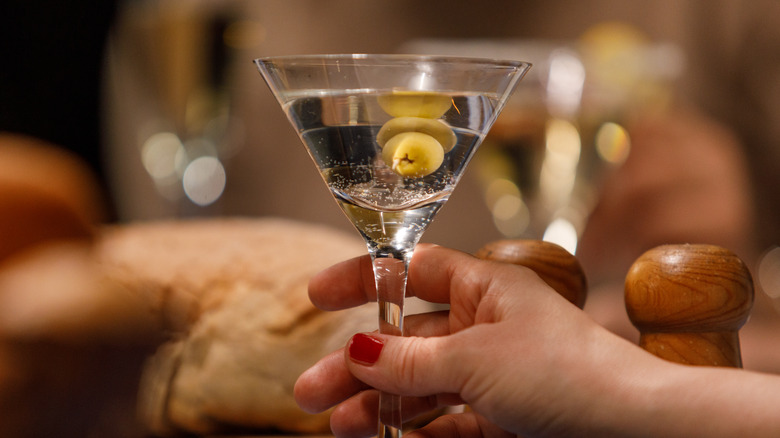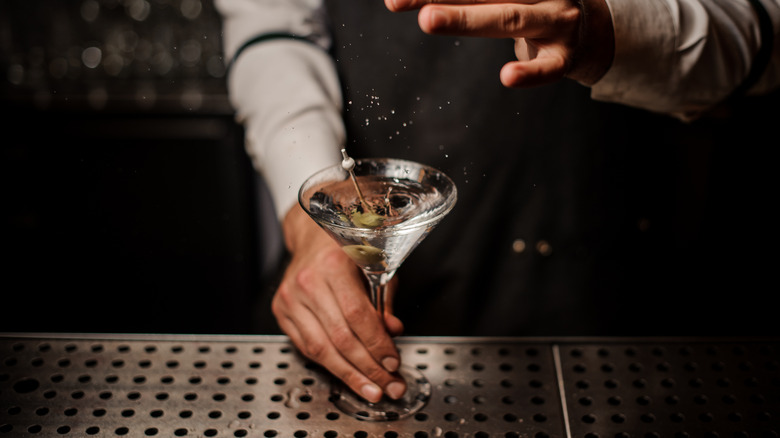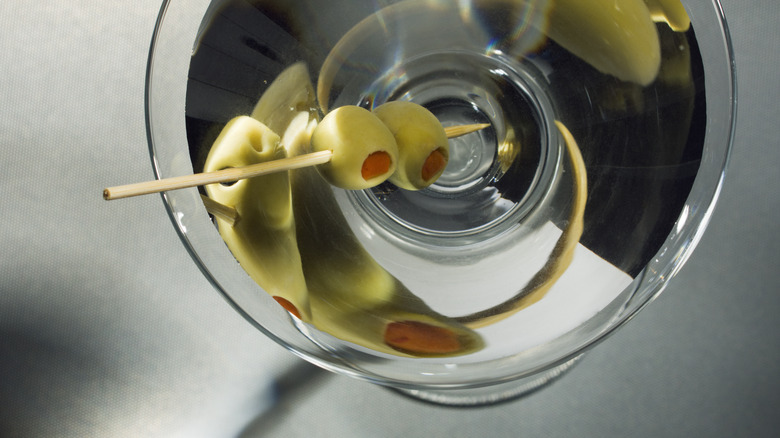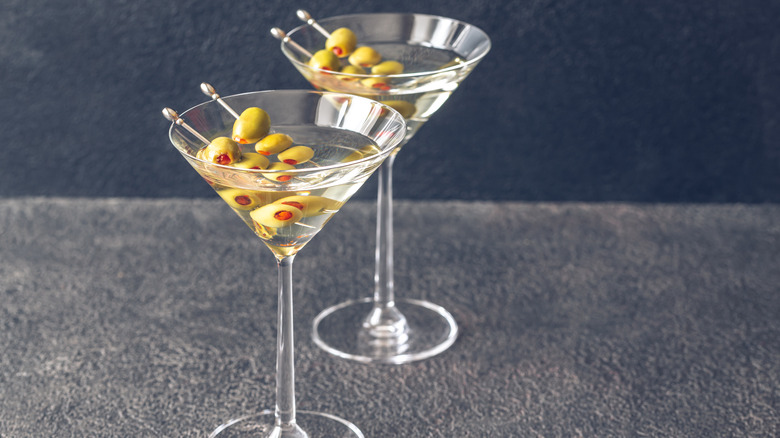What It Means To Order A Martini Dry Vs Wet
For such a simple cocktail, understanding the full breadth and vocabulary of the martini is tricky. They can be dirty, up, shaken, stirred, and served with any number of garnishes. At its baseline, a traditional martini calls for only two ingredients: dry vermouth and either vodka or gin. Of course, there are many additions to this two-ingredient dynamo, such as the special ingredient in the briny, delicious dirty martini. But some of the most common recipe variations have nothing to do with fancy add-ons or cumbersome garnishes; rather, they're concerned with the ratio of those two key ingredients.
Perhaps the two most essential variations of the martini are wet and dry. Put simply, a dry martini has a higher ratio of vodka (or gin) to vermouth than a classic martini, whereas a wet martini has a higher ratio of vermouth to vodka (or gin). A standard martini ranges from a 3:1 to a 4:1 ratio of vodka to vermouth. The exact ratios of both wet and dry versions do vary, but a standard dry martini calls for a 5:1 ratio of vodka to vermouth. Some mixologists simply wash the glass in vermouth and dispose of it before adding the liquor, creating an extra dry martini. Then there's the wet martini, which shifts the ratio balance further toward vermouth, usually falling between a 2:1½ and a 2:1 ratio of vodka to vermouth.
What is vermouth, and how does it change your martini?
Vermouth seems to be the key difference between a bone-dry and sopping-wet martini. But what exactly is vermouth, and what does it add to your drink? Essentially, vermouth is a fortified wine that also includes several aromatics such as juniper and clove. Vermouth comes in both sweet and dry varieties, which vary in both taste and color.
A classic martini calls for the dry kind of vermouth. This variety, thanks to its infusion of several herbs, generally has a botanical taste that complements gin's similarly herbaceous flavor. This is perhaps why gin is such a popular liquor choice for the martini. But vermouth isn't just an essential component of gin-based martinis. The fortified wine helps cut the alcoholic taste of any martini, and its floral base can help smooth over the sharper aspects of the base alcohol, whether that's gin or vodka. (This is true for both wet and dry martinis.)
The amount of vermouth in your drink is entirely up to you. If you like the sharp, ice-cold kick of gin or vodka, then opt for less vermouth. If, however, you need a little bit of a buffer in the strong cocktail, a wet martini might be your go-to order.
Martinis can come dry, wet, upside-down, or perfect
Of course, wet and dry are only the start of your martini's vermouth possibilities. If, for example, you simply can't get enough vermouth, you can always try making an upside-down variation. A favorite of famed chef and author Julia Child, the upside-down martini flips the drink's typical ratio, calling for a 4:1 ratio of vermouth to gin or vodka. This drink surpasses the wet martini in its tendency toward vermouth, letting the aperitif take the spotlight in this usually liquor-heavy cocktail.
Then again, you might want to be a bit more adventurous with your vermouth of choice, in which case, you should try a perfect martini. Now, this doesn't simply refer to a well-crafted iteration of the drink. Rather, its name comes from its use of both sweet and dry vermouth. This combination makes the drink more full-bodied, giving it a bit more versatility when paired with food. A perfect martini goes just as well with a shrimp cocktail as it does with a delicious cut of steak.
The drink can also include some pretty non-traditional martini additions such as bitters and maraschino cherry juice, which brings this cocktail into the territory of the whiskey-based Manhattan. Of course, there's no wrong way to enjoy a martini — well, except maybe in the case of famous fictional spy James Bond; his order could use some work.
A history of the martini, both wet and dry
Which came first, the dry martini or the wet? The answer to this quandary is a bit foggy. In terms of recipes, the wet martini came first, but the term did not arise until much later. However, describing one as dry first started around the turn of the 20th century, when recipes began popping up in various bar books. The dry martini didn't really begin to take hold until Prohibition was put into place in 1920, though.
Due to the ban on alcohol imports and production, imported drinks such as vermouth became scant. And while distilled liquors were relatively simple to make on an under-the-table basis, vermouth wasn't as easy to replicate — and what was available was low quality and often rancid. For this reason, the fortified wine became a bar top pariah. Cocktail enthusiasts soon took to ordering their martinis dry. By mid-century, the drink became all the rage, with many eschewing vermouth as unsophisticated, citing the distilled wisdom of such legends as Winston Churchill.
Unlike with the dry martini, the wet martini isn't a strictly defined term and, historically speaking, it has a bit of a derogatory tinge. In recent years, however, the tides have turned for the wet martini, as many drinkers have rediscovered the delicious possibilities of good vermouth. The cocktail lovers behind this resurgence view the aperitif as a sadly misunderstood alcohol — and one that you ought to add to a martini.



